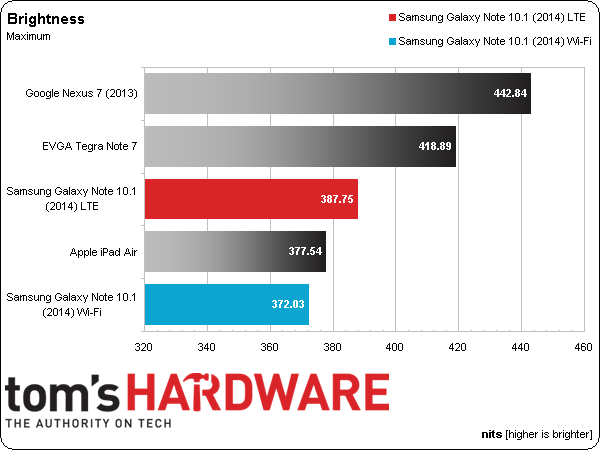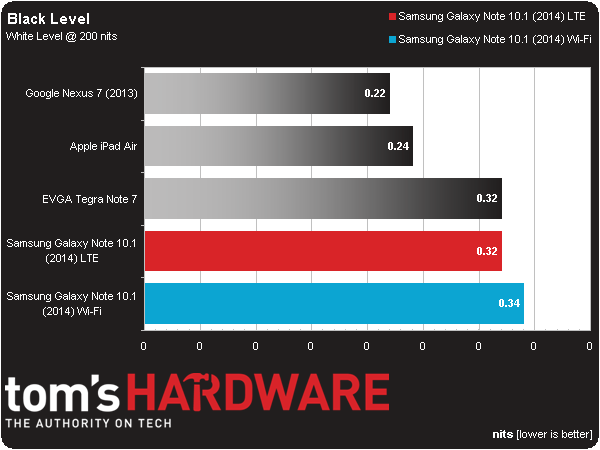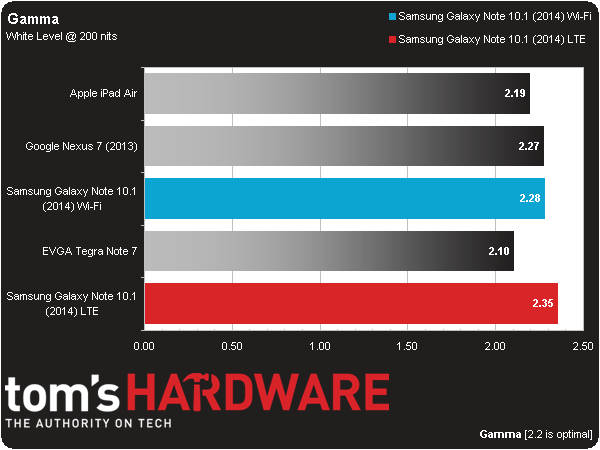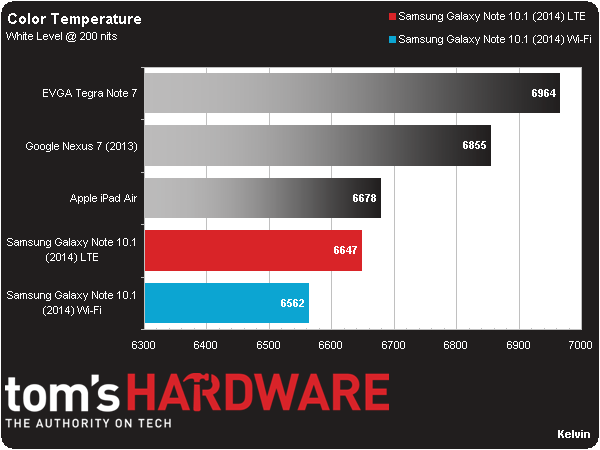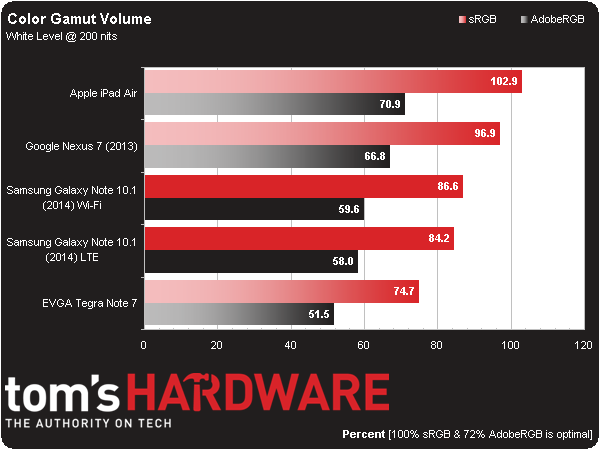Samsung Galaxy Note 10.1 (2014 Edition) Review: Wi-Fi Vs. LTE
Today's review of Samsung's Galaxy Note 10.1 (2014 Edition) includes the LTE-capable and Wi-Fi-only tablets, allowing us to compare Samsung's own Exynos 5 Octa platform to Qualcomm's Snapdragon 800. Can either configuration usurp Apple's iPad Air?
Why you can trust Tom's Hardware
Brightness, Black Level, Contrast Ratio, And Gamma
Brightness
Brightness (also known as white level) measurements are taken by recording the luminance output of each device displaying a full white pattern, with the device's brightness slider set to both minimum and maximum values.
Both Samsung tablets offer excellent minimum brightness levels and respectable maximums. The Nexus 7 (2013) shows the widest range, with a respectable lower level and the brightest display of the five units when set to max.
In order to make device comparison possible, the rest of our display measurements, along with our battery testing, are performed with the screen set to a standardized white level of 200 nits.
Black Level
Our black level measurement is the luminance output of a full black pattern after the luminance output of full white has been standardized to 200 nits. It's important to note that AMOLED displays will always measure a black level of zero, since their pixels simply turn off to render black.
Traditionally, Samsung's AMOLED-equipped devices dominate in this benchmark, as AMOLED displays have, indisputably, the best black levels. In this test, the Nexus 7 (2013) does very well, followed by the iPad Air's Retina display. The Tegra Note 7 and both models of the Galaxy Note 10.1 (2014 Edition) don’t do quite as well.
Contrast Ratio
Contrast ratio is the difference between a full white pattern and a full black pattern. Due to their zero reading on the black level tests, AMOLED displays are said to have an infinite contrast ratio.
If there is another test where we would have loved to see one of Samsung's renowned AMOLED displays, it would be this one. In this case, the Nexus 7 shows the best contrast ratio, followed closely by Apple's iPad Air. Both the Wi-Fi and LTE variants of the Galaxy Note 10.1 (2014 Edition) finish with relatively disappointing results compared to the competition and Samsung's own AMOLED-based devices.
Get Tom's Hardware's best news and in-depth reviews, straight to your inbox.
Gamma
A gamma curve of 2.2 is what we optimally want to see. The reason for this is that images captured in the sRGB color space are encoded in a gamma of about 1/2.2. A gamma curve of 2.2 allows the resulting images to be viewed at the ideal brightness and contrast.
In gamma testing, the iPad Air comes out on top with a score closest to the ideal value of 2.2. The Nexus 7 (2013) and Galaxy Note 10.1 (2014 Edition) Wi-Fi come close as well. EVGA's Tegra Note 7 is off a bit, while the Galaxy Note 10.1 (2014 Edition) LTE is further away from the mark. While this might seem odd, considering that the LTE and the Wi-Fi models share the same screen, we know that LCD panels, even of the same make and model, vary from one unit to the next. This is an excellent example of that in practice.
Color Temperature
Color temperature is a measurement in Kelvin, which is used to describe how “warm” or “cool” a given display is. Ideally, as long as you're not viewing your device in direct sunlight, this should be in the 6500 range. Higher color temperatures result in a cool, bluish hue, while lower temperatures deliver a warm or reddish tone.
In color temperature measurements, the Note 10.1 (2014 Edition) Wi-Fi come very close to 6500, followed closely by the LTE version, at around 6650. The iPad Air follows in third place. Out of the five tablets tested, these three are the most balanced. The Nexus 7 (2013) and Tegra Note 7 both fall a bit on the colder side, though not enough for their displays to be considered poor.
Color Gamut
Our volume measurements are compared against both the sRGB and AdobeRGB color gamuts. A reading of 100 percent on sRGB and 72 percent on AdobeRGB is the optimal reading for viewing the vast majority of digital consumer content. A lower reading is typically accompanied by an overly red or yellow image, and a higher reading is usually too blue/green.
Since the two versions of the Galaxy Note 10.1 (2014 Edition) have the same LCD TFT display, we aren't surprised to see that both tablets measure essentially the same. The iPad and Nexus 7 (2013) are a few percentage points closer to their ideal targets, while the Tegra Note 7 leaves a bit to be desired. Both variants of the Note 10.1 (2014 Edition) fall somewhere in between.
This is another test where the Note 10.1's use of TFT, as opposed to Samsung's hallmark AMOLED, sets this tablet apart from the rest of the company's offerings. Typically, the AMOLED's nearly full-AdobeRGB gamut volume is a potential liability, since most digital content is made for sRGB. Unfortunately, the Note 10.1's TFT isn't right on the money either, and its less-than-sRGB gamut may be a shock to those coming from the company's AMOLED devices, as sub-sRGB gamuts typically appear too red/yellow, while the volume on 100% AdobeRGB devices appear too blue/green.
Current page: Brightness, Black Level, Contrast Ratio, And Gamma
Prev Page Results: Web Benchmarks Next Page Results: Battery Life-
blackmagnum The only possible way Samsung mobile devices can be a worthwhile alternative to Apple is when they ditch the every-man Android and create their own tightly controlled/ managed OS like Apple. Do that and consumers might not feel like they're just buying the Samsung for the hardware.Reply -
Farrwalker On page 7. Results: CPU Core Benchmarks:Reply
Your bar graph "MobileXPRT 2013" seems to be in error.
For example, the text says, "Note 10.1 (2014 Edition) Wi-Fi leads with 300 points . . ."
but the bar is the shortest and indicates less than 150 points.
-
blueer03 You need to proofread this big time. From page 9:Reply
Samsung's Exynos-based Note 10.1 (2014 Edition) Wi-Fi holds its own against the Tegra Note 7, while the LTE version of the Note 10.1 (2014 Edition) again falls significantly behind its Snapdragon 800-powered Wi-Fi counterpart.
And this happens all throughout. The LTE is a Snapdragon, the Wifi is an Exynos. Keep repeating that to yourself as you re-write the descriptions and it will make this easier to read. -
Kevin Harrelson We got one of these for my son (age 13) to help with his school work. We got it from Best Buy and got the extended warranty. Both sound dumb, but it was actually a good move! The backlight has gone out on this thing TWICE. I happen to think that it is a lovely little tablet, but the backlight is a major reliability issue.Reply -
adamovera ReplyOn page 7. Results: CPU Core Benchmarks:
This benchmark's sub-tests produce scores in seconds (lower is better), and the overall score is given as a typical higher-is-better score, so the lowest bar indicates the fastest completion. Sorry about the confusion, I'll look into other ways to represent this test.
Your bar graph "MobileXPRT 2013" seems to be in error. For example, the text says, "Note 10.1 (2014 Edition) Wi-Fi leads with 300 points . . ." but the bar is the shortest and indicates less than 150 points.
-
adamovera ReplyYou need to proofread this big time. From page 9:
Good catch, thanks! Fixed.
Samsung's Exynos-based Note 10.1 (2014 Edition) Wi-Fi holds its own against the Tegra Note 7, while the LTE version of the Note 10.1 (2014 Edition) again falls significantly behind its Snapdragon 800-powered Wi-Fi counterpart.
And this happens all throughout. The LTE is a Snapdragon, the Wifi is an Exynos. Keep repeating that to yourself as you re-write the descriptions and it will make this easier to read. -
Tomtompiper The 2014 is almost 5 months old and has been superseded by the Amoled screened Galaxy Tab S 10.1 which wipes the floor with the opposition. http://www.gsmarena.com/samsung_galaxy_tab_s_105-review-1097.php Do try to keep up!Reply -
adamovera ReplyThe 2014 is almost 5 months old and has been superseded by the Amoled screened Galaxy Tab S 10.1 which wipes the floor with the opposition. http://www.gsmarena.com/samsung_galaxy_tab_s_105-review-1097.php Do try to keep up!
Actually, you'd think this has been phased out, but it's the current 10-inch Galaxy "Note" product, meaning it has the S Pen. The Galaxy "Tab" S does not - still unclear to me what makes the "S" stand out. I believe Samsung is literally attempting to offer an alternative product to every single other device in existence - complete mobile domination. I lost count of their current "Galaxy" line at 11 products, and that was awhile back.
The duo of Note 10.1 (2014)'s came in very handy both as comparison data in other articles and as testbeds for compiling our benchmark suite. Unfortunately, the article had to be pushed back several times, but the huge hardware difference between products carrying the same name was always something we wanted to illustrate, initially for the chipset-vs-chipset angle, but later for the optimization aspect as well. We're currently working through a small backlog of mobility articles, but each will be more timely than the last. My apologies. -
Blazer1985 I really wish Samsung could help the end user distinguish what they are buying. The 2 Note are classified as "LTE" and "WIFI ONLY" which sounds like 2 equal devices except for the sim card slot while they actually have a totally different soc.Reply -
vaughn2k ... and Samsung prices are now on par with Apple's. others are okay. Will wait for Asus and other competition. Should be cheaper though...Reply

